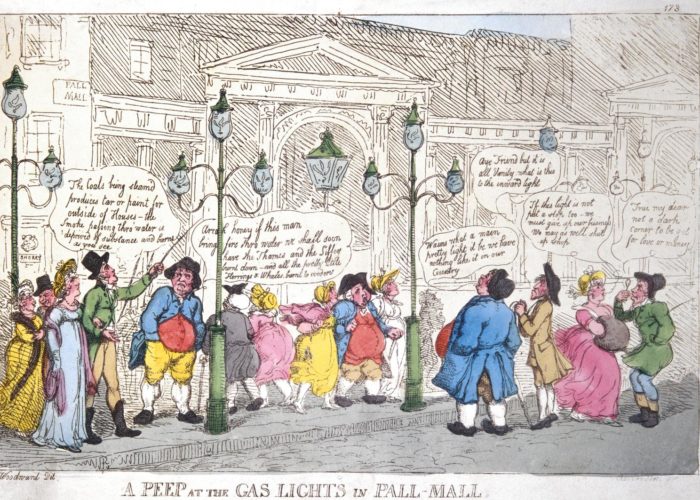A peep at the gas lights in Pall Mall
Before the 1800s, most homes, workplaces and streets were lit by candles, oil lamps or rushlights (rush plants dried and dipped in grease or fat). But these gave off a very dim light and could be smoky. In 1792, the Scottish engineer and inventor William Murdoch (1754-1839) made an extraordinary discovery which would transform not only lighting, but heating, cooking and all sorts of other activity and industry. Experimenting in his back garden in Cornwall, he found a way to produce gas, by heating coal in a closed container and collecting and cleaning the smoke. He piped the gas into his house, made holes in the pipes and lit the gas there. This produced a light much brighter and safer than from candles or oil lamps.
The first public gas lighting in Britain appeared in London’s Pall Mall, in 1807. By 1850 it had been adopted by towns and cities across Britain. The lamps were relatively efficient and cheap to run, and, despite some early scepticism, were generally seen to help increase public safety and reduce crime. Gas was used to light street lamps until the 1950s when it was replaced in most areas by electricity.
At first, the cost of gas was high and only the wealthiest could afford to use it to light their homes. But by the 1830s, greater competition and more efficient means of production had reduced the price by as much as three-quarters and gas lighting became increasingly popular in middle class houses across the UK – particularly in urban areas. This really took-off after gas fittings were introduced in the new Houses of Parliament in 1859, but it wasn’t until the late 1800s that most working people could afford to light their homes, heat water and cook with gas.
Gas lighting proved immediately popular with the factory and mill owners of the 1800s – especially those in the textile industry, as it was safer, cheaper and brighter than the alternatives. While this was a revolution for the owners, it was not such a welcome innovation for everyone. Efficient lighting meant production could now start before sunrise and continue after sunset, meaning shifts as long as 14 hours for the men, women and children workers.
Another popular use of gaslighting was in theatres. Where previously, audiences had peered through the candle or oil-lit gloom, stages were now fully lit by rows of gas flames. Staff no longer had to tend to candles during performances, actors wore less make-up and had no need to exaggerate their performances, and the audience focused more readily on the show than on shouting, socialising or fighting with each other.
Did you know..?
There are still 1500 gas lamps operating in London. Five ‘lamp attendants’ are employed to maintain them, riding between them on motorbikes and using ladders hidden in strategic places to ‘climb’ the lamp posts.
Watch them at work here.
Find out more about the history of Gas lighting, cooking and heating here.
Use our Classroom resources to investigate the Technological revolution and this image further.
Highlights:
- Using objects, artworks and other sources to find out about the past
- Green Screening: use a simple GreenScreen app to travel back to a revolutionary event from the past
- Image of the day – stimulate students’ curiosity and hone their skills of deduction
And much more…
Sources & acknowledgement
This object description and its related educational resources were researched and written by our team of historians and education specialists. For further information see the item’s home museum, gallery or archive, listed above.
-
Did you know..?
There are still 1500 gas lamps operating in London. Five ‘lamp attendants’ are employed to maintain them, riding between them on motorbikes and using ladders hidden in strategic places to ‘climb’ the lamp posts.
-
Education overview
You can access a range of teachers resources related to this object and more on our education page.
Please also see our glossary of terms for more detailed explanations of the terms used.
-
Curatorial info
- Originating Museum: Science Museum
- Accession Number: 1934-175
- Production Date: 1807
- Creator: Thomas Rowlandson
- Original record
-
Use this image
You can download this image for personal and educational use but please take note of the license type and rights holder information.
- Rights Holder: Science Museum Group
- License Type:



